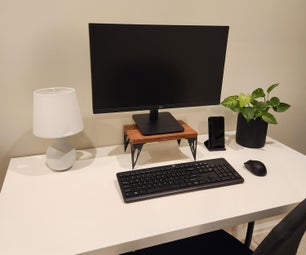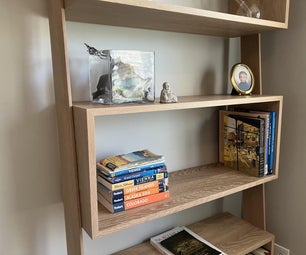Introduction: "Phi" Wall Art
My bedroom has a large, flat, boring wall that needed a little character. After browsing through thousands of overpriced wall décor pieces online, I decided to make my own. I knew I wanted something wood, in an abstract shape, but also something that had a little meaning behind it. What I came up with is an arrangement of wood sticks all sized and positioned by following the “Golden Ratio”
What is the “Golden Ratio”? Per Wikipedia: “In mathematics and the arts, two quantities are in the golden ratio if the ratio of the sum of the quantities to the larger quantity is equal to (=) the ratio of the larger quantity to the smaller one. The golden ratio is an irrational mathematical constant, approximately 1.6180339887” This interesting Ratio, also referred to as “Phi”, occurs all throughout nature, music, renaissance art and architecture. It has also been said to play a role in the human perception of beauty. (For example, if the spacing of a person’s facial features mimic the golden ratio, then they appear more beautiful than those whose do not)
Step 1: Materials and Tools
6) 6’-0”x ½”square pine strips (choose the straightest pieces possible)
24) #8 x 1” wood screws
2) Picture hangers
1) Can of Stain (Red Oak)
1) Can of Stain (Golden Oak)
1) Can of Wood Conditioner
Saw (Circular saw suggested for straighter cuts)
Drill w/ countersink bit
Sander w/ 220 grit sandpaper
Tape Measure
Rags
Gloves (recommended) Note: The stain will dissolve latex gloves so use something heavier.
Wood Clamps (recommended)
Step 2: Layout & Design
There are two lengths of sticks. 3’-0” and 1’-10 ¼” These lengths follow the golden ratio. The location where these sticks cross each other is also a function of the ratio and their lengths. 5 groups were created and then merged together. Where these groups intersect a “golden Rectangle” was created.
Step 3: Cut the Pieces
You will need to cut 7) 3’-0” pieces and 6) 1’-10 ¼” pieces. (Refer to the attached plans) Piece “A” is a very prominent piece, and sticks out quite a bit, so be sure to pick your straightest piece for this one. To ensure all the pieces were the same length, and square, I cut each one a little too long. Then I clamped them together and cut the ends off using a circular saw.
NOTE: The PDF plans are attached on to this step as well.
Attachments
Step 4: Sand and Stain
Sand all the sticks thoroughly, including their ends. Next coat each in wood conditioner, following the manufacturer’s instructions. Since we are using pine, the conditioner is highly recommended. Without it, the wood will soak up the stain unevenly and it will look very splotchy. Finally, stain each stick per the attached plans. ( 4 long light colored, 2 short light colored, 3 long dark colored, 4 short dark colored.)
Step 5: Mark and Drill
All of the holes will be drilled from the back face. So pick the face on each stick you want to be visible and turn them over. Mark the holes for each stick with a pencil following the attached plans. You must take care to be as accurate as possible on this step. If any of the holes are off, it will show up in the final product. Take your time and it will be worth it in the long run. Remember the holes for Lettered sticks do NOT pass all the way through, and the holes for Numbered sticks must be countersunk.
Step 6: Arrange and Attach
Place a screw in each of the Numbered sticks and run through so just the tip protrudes from the other side. Using the “reverse plan” as a guide lay each stick face down, starting with the Lettered sticks. The tips of the screws on the Numbered sticks should line up with the holes on the Lettered sticks. After all of the sticks are arranged, drive all the screws in, adjusting for squareness as your proceed. (Note: the entire piece can be shifted in and out of squareness once complete)
Carefully attach the picture hangers at the intersectiion of A/1 & F/2 and you are complete!














